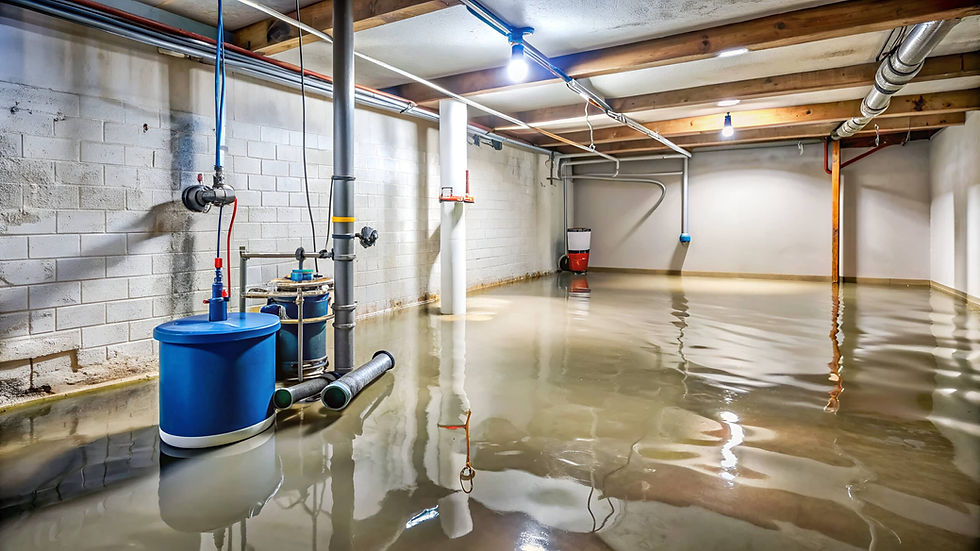Emergency Water Damage Response: What Homeowners Should Do Immediately When Flood or Seepage Occurs
- A Better Choice Inc.

- Aug 1
- 3 min read
Whether it’s caused by a storm, a broken pipe, or unexpected seepage, discovering water in your basement is a stressful situation no homeowner wants to face. But acting fast can make all the difference in minimizing damage and avoiding long-term problems like mold, structural issues, or ruined belongings.
At A Better Choice Basement Waterproofing & Structural Repairs, we’ve seen firsthand how water damage can escalate quickly—and we want you to be prepared. Here’s exactly what to do the moment you notice water intrusion in your home.

Step 1: Stay Safe
Safety comes first. Before you start assessing the damage, make sure your home is safe to enter.
Turn off the electricity to the affected area, especially if there are appliances, outlets, or extension cords near the water.
Avoid standing water if you’re unsure whether electricity has been shut off—it can be extremely dangerous.
If the flooding is from a burst pipe or internal leak, shut off your main water supply immediately.
If the situation feels unsafe or overwhelming, leave the area and call for help. Your safety is more important than anything else.
Step 2: Identify the Source
Quickly identifying where the water is coming from will help you take the right next steps.
If it's weather-related (like heavy rain), it may be a result of poor drainage, foundation cracks, or saturated soil pressing water through walls.
If it’s from plumbing, you might have a broken pipe, water heater leak, or sump pump failure.
Take photos or videos as soon as it’s safe—these can help with insurance claims and assist professionals in diagnosing the issue later.
Step 3: Stop the Water (If You Can)
If the source is a plumbing issue, turning off the main water valve may stop the flow immediately. For sump pump failures, try unplugging and resetting the unit. In some cases, you may need a plumber or electrician before proceeding.
If it’s external water intrusion, your ability to stop it will be limited until the weather clears—but make a note of where the water is entering. This will help with repairs and waterproofing after cleanup.
Step 4: Remove Water & Start Drying
If the water is shallow, you may be able to remove it yourself with a wet/dry shop vac, mop, or squeegee. For larger volumes, you’ll need professional help with water extraction.
Then, begin the drying process:
Use fans and dehumidifiers to reduce moisture.
Open windows (if humidity is lower outside) to increase airflow.
Remove wet items like furniture, boxes, and rugs to dry separately or discard if unsalvageable.
The faster you remove moisture, the lower your risk for mold and further damage.
Step 5: Call the Professionals
Even if you manage to clean up the water, the source of the problem still needs to be addressed. That’s where we come in.
At A Better Choice, we’ll inspect your basement or foundation to identify how the water got in and provide a permanent waterproofing or structural solution. We also offer ventilation options that can help dry out basements and keep air quality safe long after the water is gone.
If mold is already present or the damage is severe, we’ll recommend additional restoration or remediation steps to make your home safe and healthy again.
Step 6: Document Everything for Insurance
If you plan to file a claim, documentation is key. Take photos of:
The affected areas
Damaged items
The source (if visible)
Any repairs you make or emergency actions taken
Then call your insurance company as soon as possible to report the issue and begin the claim process. Keep receipts from cleanup services and repair work.
Step 7: Plan for the Future
One of the most frustrating things about water damage is knowing it could happen again. Once your immediate emergency is handled, the smartest thing you can do is prevent it from recurring.
Our team at A Better Choice can help you:
Install a proper interior or exterior waterproofing system
Repair and reinforce your foundation
Upgrade your sump pump and drainage systems
Improve grading and downspout extensions outside
Add air circulation systems for long-term humidity control
Don’t Wait for the Next Emergency
A flooded basement or soaked crawlspace is more than a mess—it’s a warning sign. Let us help you take control with expert waterproofing and structural repair solutions that actually work.





Comments